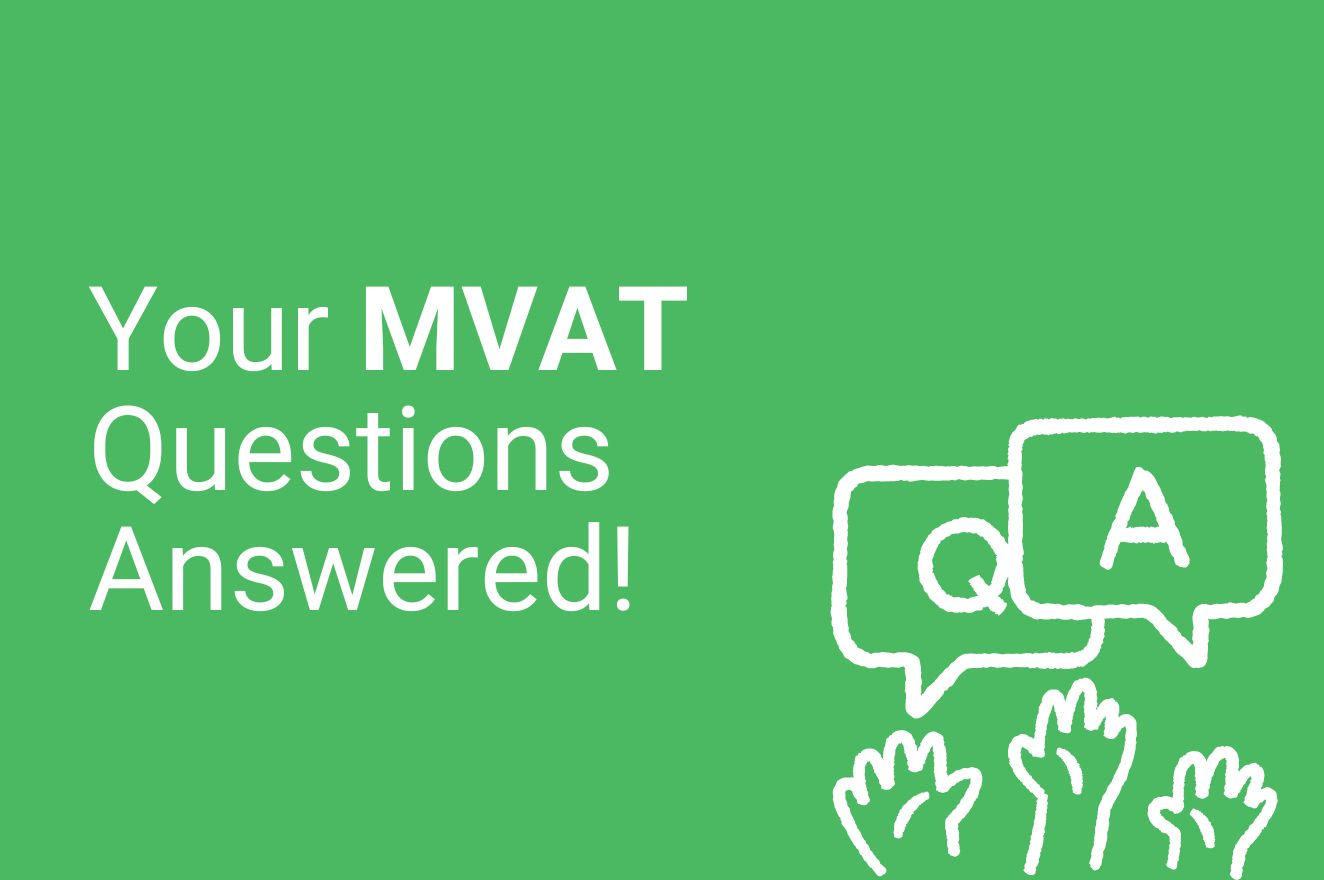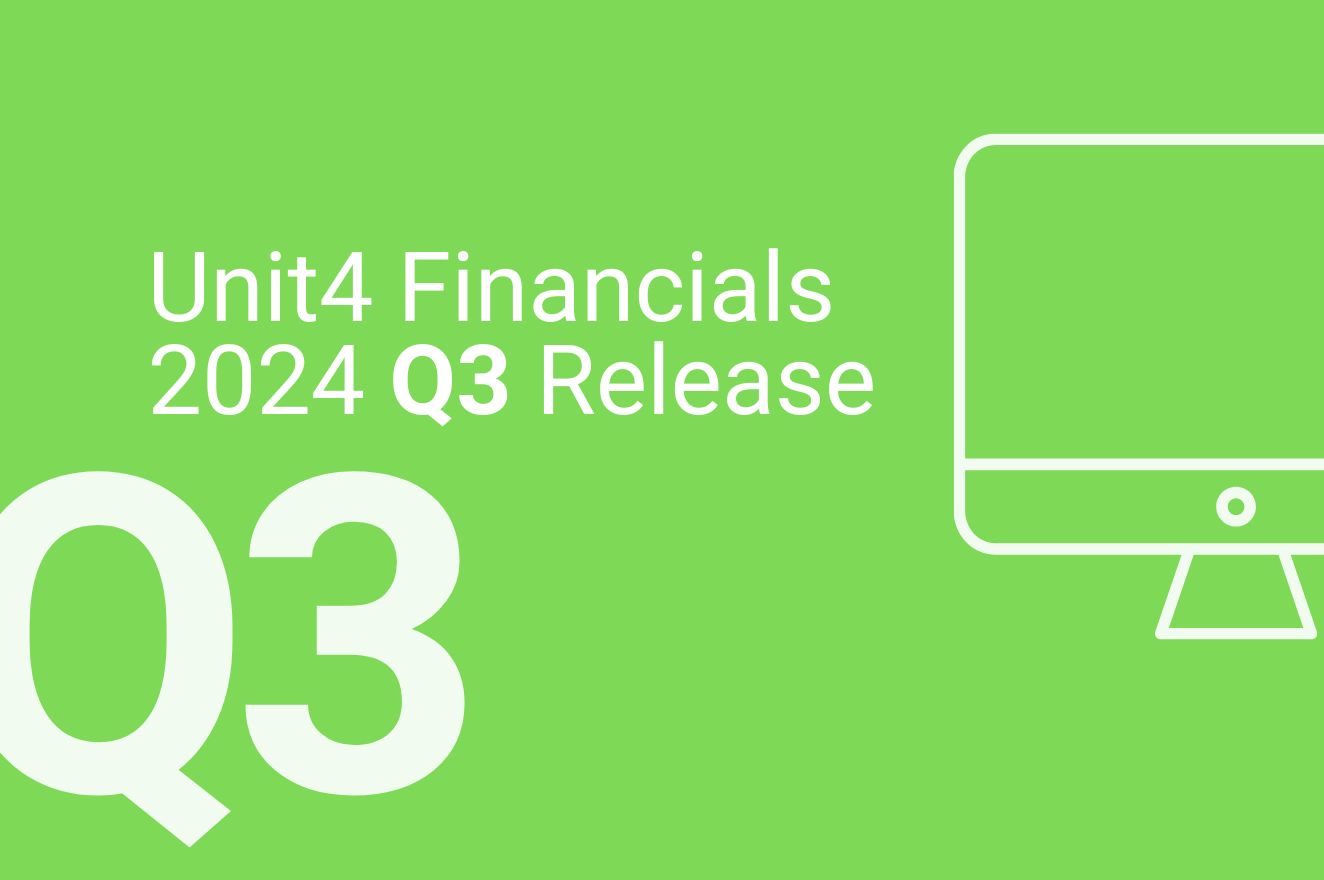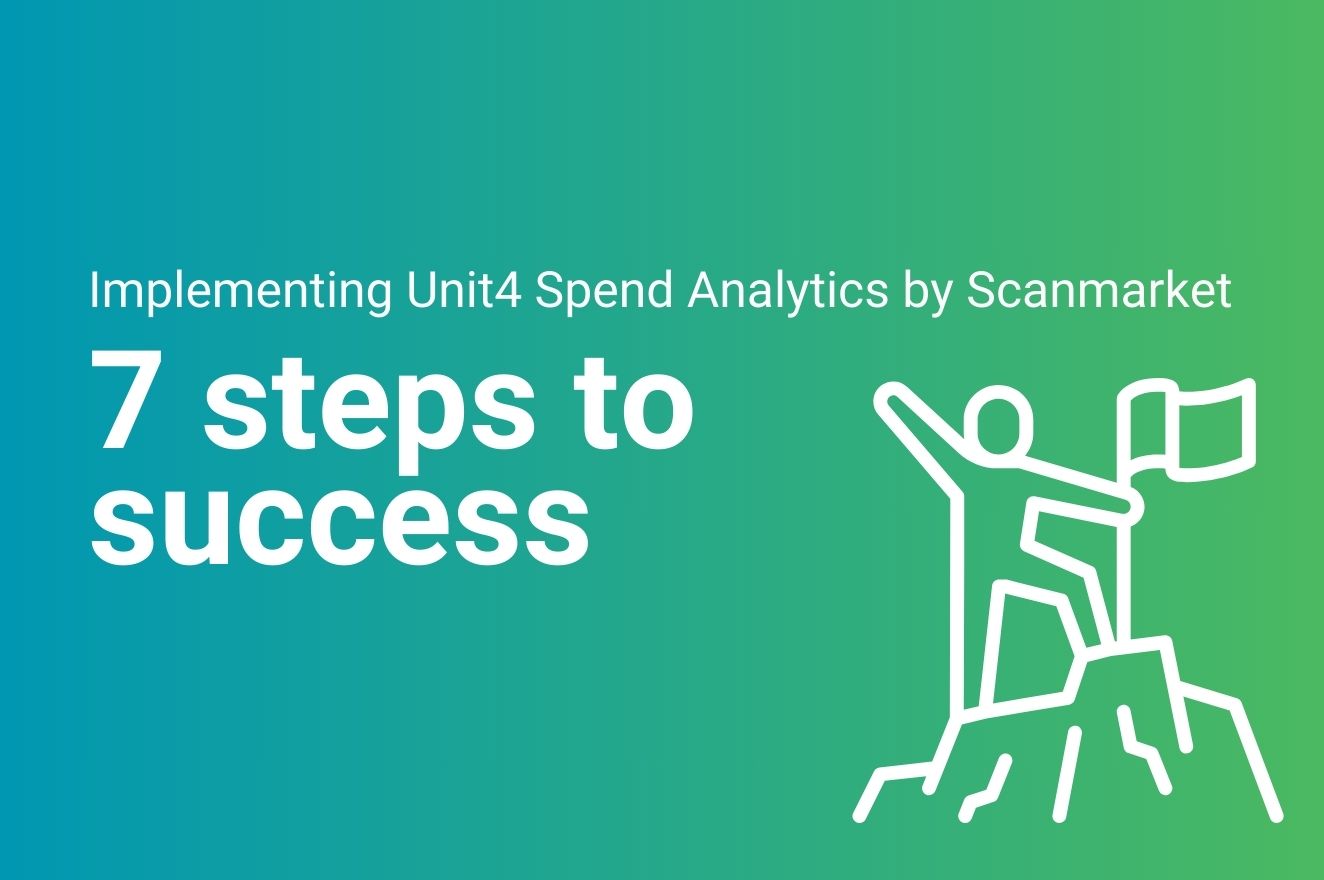Unit4 Procurement and Invoicing Matching Modules
POP and PIM
Unit4 Procurement and Invoicing Matching Modules: How they’ve changed, and how your business can benefit
Manual purchase order processing and invoice matching are among the most time-consuming and least controlled activities handled by finance teams. So how do you improve them? To reduce your admin workload, streamline approvals, and cut out maverick spending, Unit4 has the answers.
Here’s a closer look at Unit4’s Procurement and Invoice Matching functionality, how and why they are structured as two distinct modules, and the benefits they offer to your wider business.
Unit4 Procurement and Invoice Matching: What’s changed over time?
With a function-rich platform like Unit4, it’s easy for individual features – including potentially very useful add-ons – to fly under your radar. This is especially pertinent to long-term users of Unit4 Financials by Coda: courtesy of Unit4, enhancements have come thick and fast over recent years, and there may easily have been some you’ve missed!
If you first encountered Coda a few decades ago, you may have noticed a procurement and invoice matching module was available. However, built by Science Systems and badged as a Coda product, this was a separate application from the core Coda system. Interfacing ensured data exchange between Coda and the procurement module, but they were essentially two independent systems.
The significant change came in 2011 with the release of Unit4 Financials by Coda, Version 11. From then on, Unit4 offered (and still provides) two separate optional modules, one for procurement, and one for invoice matching. Unlike the previous app, these modules are both integrated within the core Unit4 Financials platform, sharing the same database and business logic.
For users, this means seamless processes with no duplication of effort. You create a new supplier, fill in the relevant details, and the new record feeds through automatically to the procurement and invoice matching modules.
Why are Procurement and Invoice Matching two separate modules?
Purchase order processing and the need for invoice matching often go hand-in-hand. So why is there a separate module for each one?
First off, let’s take a look at what each module covers:
Procurement
The module streamlines and consolidates procurement processes linked to indirect spend (e.g. supplies, equipment, and facilities management spend). Unit4 Financials by Coda is a financial management system (not a stock control system), so the module is not designed for stock procurement.
It standardises, automates, and applies controls across all stages of the procurement process. Key features include automatic routing of requisitions through an approval workflow, applying predefined rules and spending thresholds, set by you.
After approval, the system automatically generates purchase orders with all relevant info inputted. Open POs can be tracked within the system to monitor outstanding orders.
Invoice Matching
This module can be used alongside the Unit4 procurement module and can also integrate with third-party systems, including stock control systems.
The module facilitates automated three-way matching (i.e. comparing a purchase order, goods received note (GRN) and invoice) before payment is made.
Users can apply customised rules for automatic matching (e.g. payment amounts and quantities), with tolerance levels for any discrepancies.
The Procurement module performs a distinct job, i.e. automating and streamlining processes linked to indirect spend. The Invoice Matching module has wider applicability, in that it can be used for matching and reconciling both indirect and stock-related invoices. For this reason, Unit4 offers them as two distinct modules.
When you raise a purchase order in the Procurement module, the user will create a GRN on receipt of the goods. The system then automatically creates a logical receive note (LRN) in the invoice matching module. You can also configure your stock control system or other third-party procurement systems to send LRNs to the Invoice Matching module in the same way through web services.
This separation ensures flexibility for different workflows and business needs. Some businesses will choose to implement the Unit4 Procurement module for indirect spend alongside their procurement/inventory system and apply the Invoice Matching module to both. Others may have very few indirect spend transactions to administer, meaning a dedicated indirect procurement module is unnecessary. They may, however, have a large volume of inventory invoices to manage, in which case implementing Unit4 Invoice Matching – integrated with their third-party procurement/inventory system – makes perfect sense.
Benefits of Procurement and Invoice Matching Software
Effective and timely approvals
‘Why wasn’t I made aware of this spend before the budget was set? Why am I only being told of it now? Why are we still using this supplier?’ With manual or ad-hoc approvals, there’s the constant risk of maverick spend, i.e. employees committing to purchases without approval and without budget holders being able to control what’s happening.
A procurement module empowers you to standardise and streamline the approvals process. Once a PO has been issued, it is immediately routed to the relevant budget holder or manager. Different levels of approval can be applied based on, for instance, spend category or amount. Meanwhile, integration with Unit4 Financials means you can check whether sufficient budget is available before allowing the request to proceed. The result? You decide on the approval rules you want to apply, and the system ensures they are adhered to.
Enhanced internal controls
For inventory, it’s not always a simple case of placing an order, receiving the items in one neat dispatch, and settling the invoice. Multiple shipments, partial deliveries, swaps, and supplementary orders are all to be expected. But they all create additional variables in terms of keeping track of what has been received and paid for. It’s also where the scope for error and wasted cost is greatest.
An invoice matching solution makes it much easier to handle these complexities through customised controls. This includes the ability to track and manage partial shipments, ensuring that the invoiced amount matches the quantity of items received. It is also possible to apply fine-grained matching rules to handle multiple layers of conditions, such as different tolerance levels for different product categories, separate rules for high-volume or low-volume items, and differentiation between full and partial deliveries.
Better cost management
For any finance manager charged with cutting out wasted spend, Unit4’s Procurement and Invoice Matching modules can offer easy wins in multiple areas.
As we’ve seen, the implementation of tightly controlled approval workflows makes it easier to control budget overspending. It reduces the chances of employees going off-piste and ignoring your procurement policies.
Beyond this, accurate and error-free invoice matching makes it much easier to ensure that payments made are a reflection of goods actually received, avoiding not just overpayments but also penalties for late payments.
The other big advantage from a costs management perspective relates to visibility. Linking to both the wider Unit4 ecosystem and any other applications you have in play, with enhanced procurement and invoice matching capabilities, you are much better equipped to track purchasing activity in real time. This can give you valuable intel on areas where costs can be reduced, whether it’s by adjusting purchasing volumes or switching to more cost-effective and reliable suppliers.
Find out more
To explore implementing these modules, speak to us today. You can get more information about the solution’s procurement and invoice matching capabilities here:
(Article written and published September 2024)
MVAT Q&A
Your MVAT questions answered!
MVAT: Millennium’s Making Tax Digital Software for Unit4 Financials by Coda
How does MVAT account for partial exemption and special method recovery?
Partial and special recovery methods can be configured within Unit4 Financials by Coda, allowing MVAT to output correctly to HMRC.
How does this deal with groups, i.e. different companies set up in Unit4 Financials by Coda?
MVAT can handle VAT groups (I.e. a single VAT registration) as a single report combining several Unit4 Financials by Coda companies.
How does this handle other adjustments, such as the Capital Goods Scheme?
Any adjustments made in Unit4 Financials by Coda, such as changes to the initial VAT claimed during the adjustment period (e.g., under the Capital Goods Scheme), will be automatically reflected in the MVAT software.
Does the year and period need to be hard-coded in the selector?
With the flexibility in Unit4 Financials by Coda, there are several options, including softdates (which automatically select the current period) or a hard-coded date in the selector; on setup, Millennium's team will find the process that suits you best.
We have multi-currency items; how does the system convert to GBP?
Within Unit4 Financials by Coda, a company reporting VAT is typically configured with GBP as its home currency. All documents associated with this company can be converted to GBP using the foreign exchange rates established in Unit4 Financials by Coda. This conversion occurs within Unit4 Financials by Coda before MVAT requests the relevant information.
We have multi-company details against one VAT number - how will the system consolidate these?
Unit4 Financials by Coda converts everything to the home (functional) currency. MVAT reports the home currency.
What if our home currency is not GBP?
Unit4 Financials by Coda and MVAT can be configured with dual currency in mind, which, if one of the dual currencies is GBP, will allow for correct reporting to HMRC.
How many lines can be uploaded?
100 thousand+.
Is it possible to test this with our transactions before we purchase MVAT?
Yes, testing is possible. We simply need to discuss the terms involved. To initiate this conversation, get in touch:
Does it have to be installed on everyone's laptop?
No, just one installation access via a web browser.
We are part of the Cyber Essentials Scheme, which requires specific password standards and security requirements. Can MVAT meet this standard?
As of the latest update to MVAT, it is now compliant with Cyber Essentials requirements; we are happy to meet with your security or Compliance team and walk them through how MVAT meets these requirements.
One area that we struggle with is Reverse Charge. Should this be dealt with directly in Unit4 Financials by Coda before going into MVAT?
Yes. Unit4 Financials by Coda handles reverse charge.
How many users do I get?
As many as you like, it's not a user license-based product.

Millennium’s Making Tax Digital software
- HMRC Recognised
- Ensures compliance with mandatory MTD requirements
- Seamlessly integrated into Unit4 Financials by Coda
An Overview of Unit4 Financials by Coda Training
An Overview of Unit4 Financialsby Coda Training
If you need to boost your Coda knowledge and proficiency, there are multiple approaches to training that are worth considering (and some of them are even free!).
There are no set rules when it comes to software training. For onboarding, upskilling, and unlocking everything your financial management and accounting software offers, it’s all about finding an approach that matches your organisation’s needs and your preferred way of working.
With this in mind, here’s a closer look at the Unit4 Financials by Coda training options out there…
SME training
To be effective, software training needs to be directly relevant to day-to-day user needs. And especially with a feature-rich solution like Unit4 Financials by Coda, there’s no point in trying to teach every user about every new and existing aspect of it – otherwise, you’re just going to cause training fatigue.
For example, one team member is your core accounting expert. Another handles the bulk of credit management queries. A further team member is your go-to person for asset management. These are all subject matter experts (SMEs). Consider a targeted approach by delivering training to SMEs on aspects of Unit4 Financials by Coda that are directly relevant to their areas of expertise.
SMEs tend to be particularly good at understanding the training content for their peers, so when they pass that knowledge on throughout your team, it makes it more relatable.
Train the trainer
Let’s say a set of new features has been rolled out as part of the Unit4 Financials Continuous Upgrade programme – or you’ve just implemented a new sales invoicing add-on. You don’t have to train the entire finance team to use these features all in one go.
Instead, consider focusing the training on one or a handful of champions. These individuals can then cascade the training to other employees within the organisation as needed. This can be a much more time and cost effective way of distributing the knowledge through the business than training everyone simultaneously.
Use Unit4 resources
There are plenty of Unit4 resources out there.
Unit4’s customer and partner community, Community4U, is one of the best. Comprising dedicated forums devoted to specific Unit4 solutions (including Unit4 Financials) enables you to engage with other customers and partners, get in touch and ask questions, access training resources, and get best practice tips.
(All Unit4 Financials by Coda customers have access to Community4U.)
Online partner training packages
Millennium Consulting can put together a personalised Unit4 Financials by Coda training programme built for your needs, delivered in-person or virtually.
Perhaps your team is due a best practice refresher course to ensure you are making the most of your Unit4 Financials investment. Do you want to explore new possibilities following migration to the cloud? Or do you have a group of new employees who need to be onboarded?
For expert, hands-on and role-specific training delivered by an elite Unit4 Partner, find out what’s possible here: https://millenniumconsulting.com/unit4financialsbycoda/training/
Make use of free webinars!
Workflow functionality, invoice matching, FP&A Lite, how to use hierarchies… if there’s a specific aspect of Unit4 Financials by Coda that you’re unsure about, chances are there’s a recorded webinar or video that explains it. To start exploring, try the following:
- Millennium Consulting’s upcoming events: https://millenniumconsulting.com/events/
- Unit4 Financials User Group: https://financialsusergroup.com/
- Community4U: https://community.unit4.com/
- Millennium Consulting’s YouTube channel: https://www.youtube.com/@millenniumconsulting95
- Unit4’s YouTube channel: https://www.youtube.com/@unit4
Expertise at your fingertips!
From webinars and user guides through to Community4U, there is a large bank of knowledge out there to help you get the most out of Unit4 Financials by Coda. And with Millennium’s flexible, personalised approach to training, you are all set to bridge any knowledge gaps and equip users to get the most from your system.
To discuss your training options, speak to us today.
Unit4 Financials 2024 Q3 Release
Unit4 Financials by Coda 2024Q3 was made available on 10th September 2024.
The new release contains all the previous Unit4 Financials by Coda functionality, new features, security updates, and customer-identified fixes to extend the best-in-class software solution. Unit4 has addressed many customer-reported issues and hence always encourages customers to upgrade to the latest release.
Highlights of the 2024Q3 release include:
Administration:
Data Source Definition
The XA JNDI Path is now optional on the Data Source Definition master.
Billing:
Billing Browse
It is now possible to post documents to the Intray from Billing Browse. To achieve this the Finance document location should be set to ‘Intray only’.
Finance:
Browse Balances API
Browse Balances API has been changed when summarising multiple account codes to return results which are consistent with Browse Balances in the product.
Table Link Transfer Client
The Table Link Transfer Client has new parameters which enable the user to select the data to transfer by document number and code. The document code can be wildcarded.
Browse Balances
The Finance server memory requirements for large browse balance reports have been significantly reduced.
Structured Output:
UBL 2.1 Invoice Transformation and UBL 2.1 Credit Note Transformation
The following vocabulary has been added to the Invoice and Credit Note Transformations:
- Additional Document Reference Document Description (BT-123)
- Attachment Document Description
- Tax Category Name
- Invoice Line Item Classified Tax Category Name
The following warnings are no longer reported when validating the XML against the PEPPOL BIS Billing 3.0:
- [UBL-CR-114]-A UBL invoice should not include the AdditionalDocumentReference DocumentType
- [UBL-DT-25]-CharacterSetCode attribute should not be present
- [UBL-DT-26]-EncodingCode attribute should not be present
Electronic Invoicing:
Invoice Maintenance
A new Invoice Maintenance screen has been added to display any errors for invoices that have failed to post. You have the option to resubmit the failed submission(s) and to view the failed XML (for future use).
Technical:
Security Updates
The version of the Unit4 Message Hub Bridge has been updated to fix vulnerabilities.
Deprecated features:
The .NET router has been deprecated. The final release has not been determined.
32-bit XL is deprecated. We recommend the use of 64-bit XL.
The Integration Toolkit Command Centre module (ITK) has been deprecated and will be removed in a future release. The final release has not been determined.
General Fixes/Updates:
- Generic Browse now adheres to the console browse limit setting when the limit is set higher than the 5000 chunk fixed value.
- The webservices API documentation index page has been reinstated.
- The next run time is now calculated correctly for weekly scheduled task that are set to run for multiple days in the week.
- It is now possible to view the source transactions from within Browse Assets when the Presenter master for the source data contains flexi-fields.
- Browse Statements now limits the data returned to companies the user has access to.
- Shared Masters Audit now reports differences in address tags on element masters.
- It is now possible to Print and Transmit Reminders with over 5000 rows.
- Element table link with a blank or wildcarded link code now correctly loads flexi-field data.
- It is now possible to update more than 1000 rows when using Multiple Edit in Browse Transactions.
- When editing an invoice within Invoice Maintenance, the drop down for Authorising user now shows in alphabetical order.
- The “Unit4 Financials Logical Server” LSV process is now shut down when the “Unit4 Financials” application is disabled, undeployed or replaced. This prevents a problem when deploying new versions of Unit4 Financials.
Further details on the new features, security updates and reported issues can be found in the release documentation.
The release documentation for this release (and previous releases) can be found in the documentation area on the community.
The software can be downloaded from the “Software” tab on Community4U.
Reminder: On the 14th of March 2023, Unit4 deprecated the 32-bit add-in for XL for Finance and Procurement. The 32 bit add-in for XL will no longer form part of the 2025Q1 Release.
The currently planned release date for Unit4 Financials by Coda 2025Q1 is March 2025. We advise customers to upgrade to 64-bit XL before this date.
The Unit4 Financials by Coda support team will be able to advise if you have any questions.
Release dates for Cloud users
Unit4 Cloud customers are notified by Unit4 Cloud support when their pre-production and production systems will be updated. This information can also be found within the Cloud Services – Release Schedules area.
View the 2024 Release Schedule here
The Release Notes detailing the fixes and features within this release can be found in the Documentation area on Unit4’s Community 4U.
Are you making the most of Unit4 Financials by Coda?
Our Systems Health Check is designed to help you identify areas where you may be able to improve performance and ensure you extract the maximum benefit from your investment in Unit4 Financials by Coda.
Unit4 Financial by Coda Cloud: Your Future State Architecture
Unit4 Financials by Coda Cloud: Your Future State Architecture
As on-premise users of Unit4 Financials prepare to migrate to the SaaS version, this is the ideal opportunity to optimise your architecture. From integrations through to access controls, here are some essential technical aspects that should be considered.
Make the most of change opportunity
Long before Unit4 announced that it was going completely cloud-based, a large segment of Millennium Consulting’s work already consisted of helping move customers over to the SaaS version. For us, this is very much home territory; if an issue arises linked to a migration project, it’s pretty much guaranteed that we’ve encountered it before and worked out a solution.
Ensuring data integrity, dealing with third-party integrations, formulating a backup strategy, managing the people involved against a backdrop of existing commitments, encouraging user buy-in: your Unit4 Financials by Coda cloud migration project should give you experience in these and many other areas, and these lessons can be applied to whatever further SaaS implementations your business has in store for the future.
And while theoretically doable, struggling through the process alone rarely makes good business sense. Not least, because you can end up expending considerable resources and painstakingly addressing issues that others have fixed countless times, the ROI on expert input can be highly attractive, even more so when the lessons learned can be applied to future projects.
Webservices APIs
Never underestimate the value of a fresh perspective. There are more modern ways to connect to Unit4 Financials by Coda; in some cases, the legacy connections you have won’t work. For some applications, the idea of integration with Unit4 Financials might have previously been deemed too difficult to contemplate, leaving teams to grapple with manual data lifting and shifting as a workaround. Middleware and custom scripts are in place in other cases, but these legacy fixes have become less effective as data volumes have increased over time.
There are multiple ways to connect to Unit4 Financials by Coda (Millennium Consulting’s dataBridge is one example). Migration offers the ideal opportunity to review your integrations thoroughly, identify better ways to streamline data movement between different sources, and drive operational efficiency.
Connect to the replicated database service as needed
Unit4 Financials by Coda offers a powerful Azure-based replicated database service as part of its cloud solution. This service creates a copy of your production data and places it in an optimized environment, providing you with faster, easier, and more efficient data access. While direct access to the database is not typical in SaaS products, this service ensures you can retrieve your data whenever needed, enhancing your data management capabilities without compromising security.
Adopt ‘Single Sign On’
Security is paramount and implementing single sign-on (SSO) is crucial to safeguard your organisation. With the tools and functionality at your disposal, you’re fully equipped to integrate SSO seamlessly. Our team provides the expertise needed during migration to ensure a smooth implementation. Adopting SSO not only strengthens your cyber resilience but also fosters best practices in cybersecurity across your organisation.
Use it as a catalyst for modernising the rest of your estate
Use your transition to the cloud with Coda as a catalyst to modernise your entire business. This journey provides the perfect momentum to begin migrating the rest of your infrastructure, driving efficiency and innovation across your organisation.
What next?
As an Elite Unit4 Partner with over three decades of experience in financial transformation, Millennium Consulting is uniquely placed to help you not only simplify your Unit4 Migration but also to use it as a catalyst for optimising your wider business
To see what’s possible, contact us today.
(Article written and published September 2024)
Six tips to speed up your Unit4 Financials by Coda cloud migration
6 tips to speed up your Unit4 Financials by Coda
cloud migration
As on-premise users of Unit4 Financials by Coda prepare to transition to the SaaS version, Chris Peall, Director of Professional Services at Millennium Consulting, shares some essential tips on speeding up your cloud migration.

1. Begin with an MVP
Unit4 Financials is both feature-rich and flexible. In terms of functionality, configuration, data sources, add-ons, and integrations, different businesses tend to use it in different ways. In short, Unit4 Financials covers a lot, but when it comes to migration, you don’t have to execute absolutely everything all at once.
The Minimum Viable Product (MVP) approach to migration can go a long way in making the project run as swiftly and smoothly as possible. With this, a subset of essential services is migrated to the cloud in the first instance. It helps reduce needless complexity and makes identifying and quickly eliminating any bottlenecks easier.
What elements should your MVP consist of? This will vary from business to business. However, ideally, you should focus on core finance functions.
2. Use accelerators and/or bridging software for integrations
Businesses can sometimes stick with legacy software versions for too long simply because of perceived complications linked to integration. If this sounds familiar, it’s worth remembering that it’s entirely expected to have multiple integrations to deal with as part of the migration process. And secondly, there are multiple ways to manage this effectively.
Accelerators – i.e. pre-built templates and API management tools – can go a long way in ensuring your SaaS version of Unit4 Financials is integrated successfully with third-party applications and data sources. Our dataBridge solution is specifically designed to facilitate cloud migration, no matter what linked applications you have in play. Find out more here.
3. Use experienced teams
Dedicated Unit4 Financials migration experience is out there. To avoid pitfalls, delays, and costly mistakes, it makes sense to tap into it. For Millennium Consulting, migrating Unit4 Financials by Coda to the cloud is very much all in a day’s work.
4. Engage with the business users early
They are most familiar with how the solution’s various functions map onto real-life business processes. They know how the end product should be configured to get the job done.
Business users’ involvement in the migration planning stage helps ensure the migrated software meets the business’s operational requirements. Likewise, they should be directly involved in the testing process. Input is also crucial for migrating and configuring a solution that teams are more likely to embrace, reducing resistance to change, and ensuring smoother adoption.
5. Engage with other 3rd parties early; they don’t all like change
Procurement, point of sale systems, payroll, inventory management, HR, CRM… These are just some of the categories of applications that you may have in your tech stack and that are integrated with Unit4 Financials. Especially if you have a niche, industry-specific software in play, you need to liaise with those vendors to ensure that everything will run as it should post-migration. Not all third-party applications will be immediately compatible with your new cloud-based version of Unit4 Financials, and custom integrations may need to be adjusted or rebuilt for your new cloud environment.
Liaising early with the vendors lets you know precisely what work needs to be done and gives you the option of working together on customising integrations and conducting testing before going live.
6. Identify any time constraints up front (leave, audits, etc)
You can’t UAT during the finance department’s preparations for year-end, people have annual leave; there will be other projects and programmes… these types of logistical snags can quickly build up, leading to significant delays overall. Pushing a project ‘to the right’ delays your ROI.
It’s hard to overestimate the value of a seasoned project manager in speeding up delivery and avoiding bottlenecks. Proactive planning around tasks, milestones, and deadlines, a thorough understanding of organisational dependencies, and effective communication are all essential to keep your project on track.
Going it alone increases the likelihood of unforeseen snags and delays. But fortunately, you don’t have to. As an Elite Unit4 Partner, Millennium Consulting offers everything you need to facilitate a swift, pain-free migration to Unit4 Cloud.
School fees VAT: How bursars can get equipped to manage the changes ahead
School fees VAT: How bursars can get equipped to manage the changes ahead
With the new government set to press ahead with its plans for VAT on school fees, now is the time for schools to assess the likely impact and weigh up possible responses.
Leadership teams, staff, and parents alike are looking to bursars for answers. In this blog post, Millennium’s Director of Professional Services, Chris Peall, shares the upcoming changes and the capabilities finance teams need to determine the best way forward.

VAT on schools fees: what we know so far
Currently, the supply of education provided by an “eligible body” is exempt from VAT. Academies, colleges, universities, and independent schools all generally fall under the eligible body umbrella. The exemption also covers the provision by eligible bodies of goods and services “closely related” to the supply of education (e.g. catering, boarding, and sporting facilities).
Prior to the general election, Labour said it would remove this exemption as it applies to independent schools and apply the current standard rate of 20%. Post-election, the proposal was included in the King’s Speech. Therefore, it seems certain to go ahead.
The government will need to amend existing VAT legislation in order to remove the eligible body exemption from private schools while retaining it for colleges, universities, and academies.
However, there are multiple potential grey areas that will need to be addressed in any legislation. For instance, Labour previously confirmed that the new VAT regime will not apply to pupils with an educational, health, and care plan (EHCP). Will fees for pupils with an EHCP remain exempt in their entirety – or only to the extent to which the school receives payment from a local authority? What about schools which support pupils with particular needs, but who may not have an EHCP? Will nursery services provided by independent schools also be covered? What about institutions that provide education within specific targeted sectors (e.g. religion)?
All of these issues will need to be clarified in the draft legislation.
When will the changes take effect?
The government has stated its intention to press ahead with the changes as soon as possible.
As detailed above, changes will need to be made to primary legislation, although given the size of the government’s majority, it is likely that even with some deliberation and consultation, these changes will be pushed through relatively quickly.
Most likely, the next big announcement will come in the October Budget, with legislation and guidance for schools published shortly afterwards. The new rules could conceivably start applying to fees from September 2025.
Considerations for school finance teams
Matters to consider include the following:
MTD compliance
If yours is one of the majority of independent schools not currently registered for VAT, you will likely need to register shortly after the law changes and within the specified timeframe.
For many bursars, this will mean first-time contact with HMRC’s MTD (Making Tax Digital) VAT regime. In summary, MTD compliance involves filing your VAT return through functional compatible software, keeping records digitally, using digital links to transfer or exchange data, and using the checking functions within your software to ensure returns are accurate.
As an early preparatory step, you should ensure that your current systems can accommodate this extra compliance step. Does your current accounting software include MTD capabilities? Are you clear on how to set it up?
Managing the administrative burden
As we’ve seen, the precise rules still need to be firmed up. However, it’s easy to see how schools could find themselves having to apply a complex mix of exemptions and partial exemptions on a pupil-by-pupil basis—especially when it comes to pupils with specific educational needs.
In addition, there may be extra rules to negotiate—again, potentially on a pupil-by-pupil basis—regarding ancillary services, such as nursery provision, transport, and tuition.
Rather than simply bracing for impact before the rule change is introduced, this is the right time to review your existing capabilities. Special emphasis should be on automated invoicing and tax calculations: reducing errors and saving time.
Exploring what’s feasible
To what extent can we absorb the impact of the change, and how much of it will we need to pass on to parents? This is the big question for school leaders. All eyes are on finance teams to provide the answers.
For this, you need the whole picture. In particular, a corollary consequence of VAT registration will be that VAT on costs will be recoverable in new areas (e.g. maintenance, agents fees, building works, and professional services). The same goes for VAT on capital items, such as buildings that are less than ten years old. All of this should be looked at when analysing the financial impact of the change.
Avoiding expensive mistakes
What if we announce a fee freeze for the next three terms to assuage parents’ fears? What if we announced an increase of no more than 5% per school year for the next couple of years? What if we instigated a fees-in-advance scheme?
In terms of formulating a response, there are multiple possible options out there. Asking “what if?” is easy; the hard part is formulating answers you can trust.
How do we formulate a plan, come up with a revised fees policy – without sleepwalking into a major cash flow crisis further down the line? There are no easy answers.
What next?
For over 30 years, Millennium Consulting has been equipping finance departments to navigate crises and deal with major change. For schools, now is the time to review your capabilities, ensure you are equipped for MTD, boost visibility across all areas of your organisation, and improve your ability to make the right decisions.
To see what’s possible, contact us today.
(Article written and published August 2024)
Evaluating your Current Process: Unit4 Financials by Coda Cloud Migration
Evaluating your Current Process: Unit4 Financials by Coda Cloud Migration
Whether you have already migrated to the Cloud, are currently in flight, or are still in the planning stages, this blog post will share why a switch to SaaS provides the perfect window for process evaluation, along with a closer look at the areas to focus on…
Many users of Unit4 Financials by Coda have either migrated to SaaS already or are planning to do so in the very near future. But there’s more to SaaS than just the ‘same old’ product delivered in a different way. More widely and depending on the combination of licenses you opt for, moving to SaaS enables you to access features of the product that you may not have had previously.
With Unit4 Financials by Coda software as a service (SaaS) you get six main areas of the product:
- Financials
- Procurement
- Assets
- Billing
- Travel & Expenses
- Financial Planning & Analysis
Compared to on-premise deployments, SaaS can provide access to a wider pool of features and opportunities to elevate your processes and better meet the needs of your business. In order to know what features and functions are best suited for you, you have to know and take it back to the basics of what you are actually trying to get out of the system in the first place.
Review your current process
Have your requirements and use cases changed?
Some companies have been using Unit4 Financials by Coda for a very long time, because it’s a great system! Over time, however, customers have sometimes upgraded to the latest versions of Coda without necessarily reassessing their needs. New capabilities may have been made available, and users have passed over the opportunity to put them to work.
Do you have process debt?
“This is the way we’ve always done it, so why change now?”
You have the technical capabilities to optimise core processes. But despite this, inefficient, outdated or redundant workflows still remain firmly in place. The accumulation of this is known as process debt. Over time, this can significantly erode the operational effectiveness of your business.
Align your requirements with your business strategy
Looking closely at your strategic goals, you should assess what additional functionalities you require to help achieve them. It is then worth systematically reviewing the features and functionalities available through Unit4 Cloud. Are there features that we have overlooked that have potential strategic value? Are we failing to get the most out of functions we are using already?
Do today’s requirements match the system functionality
This goes bi-directional; you need to ask yourself that question and align your requirements to your system functionality to make sure you are getting the most out of it.
Identify the cost savings of using new features/functions
This allows you to make an informed decision as to whether you then want to apply changes and change your business process to tap into the enriched features and functions that you have and to start using the ecosystem fully.
Start using the ecosystem fully!
System evaluation is not about putting each and every software function to work just for the sake of it. And certainly, for a comprehensive and well-established solution such as Unit4 Financials by Coda, there are bound to be some features that simply are not relevant to your business.
Rather, it’s about making sure your usage is properly aligned with your needs. An external appraisal from someone who knows the solution inside out – and who can apply this knowledge directly to your processes – is one of the most effective ways to achieve this. A systems review helps ensure that these capabilities are identified and put to use.
Are you missing out on ‘easy wins’ to boost operational efficiency? The Millennium Consulting Systems Health Check equips you to extract maximum benefit from your existing Unit4 Financials by Coda investment.
Implementing Unit4 Spend Analytics by Scanmarket: 7 steps to success
Implementing Unit4 Spend Analytics by Scanmarket
7 steps to success
What are we buying, and from whom? What can we do to make procurement work better for our business? Available as part of Unit4’s range of source-to-contract modules, Unit4 Spend Analytics by Scanmarket delivers the insight procurement managers and finance leaders need to understand historical and current spend, and to guide more effective decision-making.
So how exactly does it work - and what does it take to get up-and-running? Here’s how successful Unit4 Spend Analytics implementation is achieved in just seven simple steps…

Step 1: Setting up your environment
How will you access and bring together our spend data? And, equally as important, will this module work with our existing ERP, P2P and other systems?
For initial setup, you provide a flat file export of your spend data for typically the last 6-12 months from wherever it resides (e.g. your ERP or procurement system). Behind the scenes, Unit4 Spend Analytics standardises, categorises, and deduplicates that data where necessary, correcting any errors, and flagging any outliers.
Step 2: Export an initial report
Unit4 Spend Analytics enables you to connect, explore, visualise and understand all your spend data in one place. And, as you’d expect with Unit4, the solution has an “integrate with everything” approach at its core.
This includes integrations with a wealth of popular systems, including ERP (Salesforce, Sage, SAP, Oracle, Microsoft Dynamics), and procurement systems (Basware, Coupa, Sievo, TradeShift).
Rest assured, we can take care of the heavy lifting elements required in provisioning your environment. This includes identifying which data sources will be used for spend analysis, and setting up an SFTP (Secure File Transfer Protocol) server where the relevant data files will be uploaded. Data ingestion pipelines, mapping fields, user credentials and authentication methods are all configured according to your needs and preferences.
Step 3: Enhancement of your data and configuration of your environment
Unit4 Spend Analytics gives visibility on spend across all areas of your business via your choice of dashboard. But how can you be confident that the information in front of you is accurate? This is where the AI-driven data cleansing and enhancement comes in.
Behind the scenes, elements such as vendor names, commodity codes, units and dates are standardised. Additional supplier information and market data can be integrated and transactions can be categorised into predefined spend groupings according to your needs. On top of this, duplicate records are identified and merged, and common data entry errors can be automatically corrected (or else flagged up, depending on your preferences).
Step 4: Tweaking for accuracy and usability
Unit4 Spend Analytics gives visibility on spend across all areas of your business via your choice of dashboard. But how can you be confident that the information in front of you is accurate? This is where the AI-driven data cleansing and enhancement comes in.
Behind the scenes, elements such as vendor names, commodity codes, units and dates are standardised. Additional supplier information and market data can be integrated and transactions can be categorised into predefined spend groupings according to your needs. On top of this, duplicate records are identified and merged, and common data entry errors can be automatically corrected (or else flagged up, depending on your preferences).
Step 5: Initial usage
By now, your spend data has been cleansed, enriched, and categorised in line with your preferences. It’s now time to start putting Spend Analytics to work.
Featuring interactive charts and graphs, the solution dashboard aims to transform your spend data into actionable insight. Among other things, this should make you better equipped to identify spend risks, spot opportunities for cost savings, and ensure PO spend compliance.
Step 6: Collaborative refinement
As well as enabling you and your team to get familiar with the solution, thorough pilot testing and initial usage can also highlight further scope for optimisation. Examples might include the following:
- Opportunities to rationalise your spend category structure by addressing overlaps/redundancies.
- One of your first projects using Unit4 Spend Analytics may involve identifying ways to consolidate suppliers to achieve better terms. If so, it may be appropriate to further update your spend categories to reflect these changes.
- You may have identified possible further external data sources to enrich your analysis (e.g. to benchmark prices, supplier performance and/or total cost of ownership).
- Whatever you need in terms of additional configuration, spend categorisation, dashboard customisation, and setting up data feeds, we can help.
Step 7: Continuous refreshment of data
How do you ensure that up-to-date data is transferred from your ERP and other sources to your spend analytics solution? Unit4 Spend Analytics offers a choice of data transfer methods.
Especially useful for businesses with specific regulatory requirements linked to auditing and tracking, you can carry out manual data transfers using excel or any other tabular file format via your SFTP server.
Alternatively, to save time, to reduce your manual workload, and to facilitate real-time (or ‘near-time’) updates, you can opt for automated data transfer between your ERP and/or other sources and Unit4 Spend Analytics at intervals that best suit your business needs.
Spend Analytics forms part of Unit4 S2C by Scanmarket: a full suite of solutions designed to give users enhanced oversight and control over spend, the ability to make better, data-driven procurement decisions, and also maintain compliance. Find out more here.
To discuss what’s possible for your business, and to set up a demo, speak to us today.
Unleashing Efficiency: Why SaaS Outperforms On-Premise Software
Unleashing Efficiency: Why SaaS Outperforms On-Premise Software
Choosing between Software as a Service (SaaS) and on-premise software is crucial for finance professionals navigating the digital landscape. Here’s why SaaS is becoming the preferred choice.
Cost efficiency and focus
SaaS eliminates the need for hefty upfront investments. Unlike on-premise solutions, which require substantial capital for licenses, hardware, and infrastructure, SaaS uses a subscription model. This ensures cost predictability and accessibility, making advanced software available to businesses of all sizes. Outsourcing software maintenance and infrastructure management allows companies to focus on core activities, fostering innovation and strategic growth.
Automatic updates and easy maintenance
With SaaS, software updates and maintenance are handled by service providers, ensuring access to the latest features and security patches. This saves time and resources, enhancing performance and security. SaaS applications can be quickly deployed, enabling rapid implementation of new tools and functionalities for a competitive edge.
Superior User Support
SaaS offers streamlined user support with cloud-based accessibility, efficient remote assistance, and prompt issue resolution. This leads to higher user satisfaction and productivity. Monitoring tools for software performance enable proactive identification and swift resolution of potential issues, minimising downtime. SaaS support teams also prioritise data security, addressing security concerns and compliance inquiries promptly.
Scalability
SaaS solutions are designed for scalability. As businesses grow, they can easily adjust subscriptions to meet increased demands. This flexibility allows organisations to optimise costs by paying only for the resources they use.
SaaS offers clear advantages over on-premise software: cost-efficiency, automatic updates, superior user support, and scalability. Millennium Consulting has been involved in digital transformation and change management for more than three decades. And in recent years especially, that transformation typically involves helping organisations make the move to the Cloud.
Our migration experts are on hand to deliver a rapid, successful move to SaaS, enabling you to extract maximum value for your new deployment model – with minimum disruption to your business.










